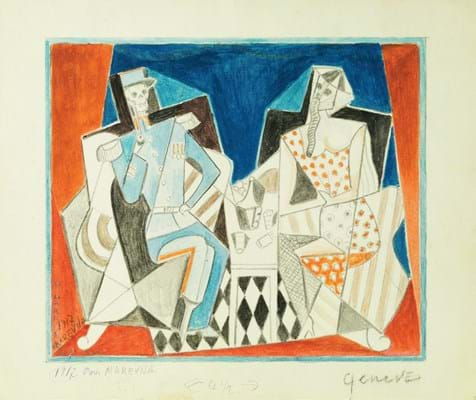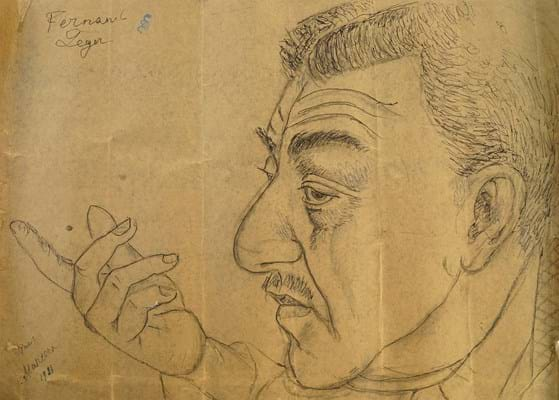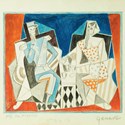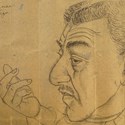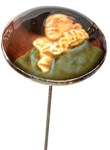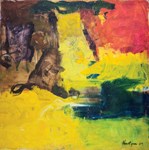Pre-war Paris was where it all started for Russian-born painter Marie ‘Marevna’ Vorobieff (1892-1984).
It was here, in 1912, that she became acquainted with some of the great artists and writers of the early 20th century, including Amedeo Modigliani, Georges Braque, Henri Matisse, Pablo Picasso and Marc Chagall.
The city was also where she met Mexican muralist Diego Rivera (who would later marry Frida Kahlo), with whom she began a tempestuous and complicated relationship that produced a daughter and continued until Rivera abandoned Paris for Mexico in 1921.
But perhaps most important to her career as a painter, it was in Paris where she first encountered Cubism, a movement that would dominate much of art and led her to being accredited as the first female Cubist painter – a legacy not widely known today.
Shedding greater light on these formative early years was a large studio collection of Marevna’s work offered at south London saleroom Roseberys (25/20/12% buyer’s premium) via the estate of the artist’s grandson, David Ellie Phillips.
Broad in scope, the 323-lot sale on December 5 in West Norwood consisted of mostly works on paper and a few oils, starting in Paris and ending with her last years in England, as well as photographs and letters.
Tess O’Brien, head of department at Roseberys, described Marevna’s early works in the sale as “like photographs… capturing the spirit and the times of a unique period in history” and “a wonderful opportunity for many collectors to buy a piece of history particularly with Marevna’s depictions of the La Ruche artists”.
Early experiments
On the secondary market, Marevna is known almost exclusively for the Cubist-style Pointillist nudes she created in the south of France before and during the Second World War, which have fetched into six figures at auction. Less sought-after is the work she created outside of this, including her early experimental years in Paris.
It is for this reason that much of the sale appealed more to academic than commercial tastes. That also probably accounted for the tepid response to a few of the pricier lots on offer, including a 1937 Cubist oil of a man in a chair, which failed to sell at a £8000-12,000 guide.
Still, over two-thirds of the sale got away with the majority of interest coming from private collectors, although dealers and institutions were also active, said O’Brien.
“We were worried that the current trend in the Russian art market would affect this sale,” she said. “However, we saw bidders from all over the world including Russia, the US, China and France.”
Marevna’s strongest performing early Cubist images were two different versions of the same striking First World War composition: a pipe-smoking soldier with a skull for a face opposite a woman wearing a gas mask. The marginally more expensive version was a 6 x 7½in (16 x 19cm) gouache and pencil work, inscribed Paris 1917. It tipped over top estimate to sell to a phone bidder at £3200.
The other work, an identically sized mixed-media gouache watercolour on card, also sold to a phone bidder on top estimate at £3000. It too was inscribed Paris, but the artist had gone back at a later date to add blue pen and re-date the work to 20-3-1918 in the margin. It was one of a number of works that had been reworked and or dated later by Marevna, sometimes many years later, which may have impacted a little on their value.
Marevna’s copy of Joseph Fernand Henri Léger’s famous The Staircase (Second State) was one of a number of examples where bidders were presented with an opportunity to acquire a contemporaneous copy for a fraction of the price of an original.
Marevna had almost certainly seen the picture, which is now in the Museo Thyssen-Bornemisza in Madrid, when she visited the painter’s studio in Paris in c.1914.
At the time, Léger was striving to capture the contrasts of fastpaced modern life through pictorial contrasts, combining Cubism with the use of colour.
The 17 x 12in (44 x 31cm) oil and pencil on paper sold to an online bidder at £1300, 13 times the estimate.
Imitating styles
In a similar vein was a job lot of five watercolours with traces of charcoal imitating the painting styles of Chagall, Braque and Picasso. Again, the appeal to own work in the style of world-famous painters, created by a friend who worked beside them, ensured they sold for a multi-estimate £1500.
The sale included a portrait of Léger: a 15 x 18½in (39 x 47cm) black ink and pen and charcoal drawing that had been rolled up in a cupboard for many years. Dated two years later, in 1916, this early depiction of the painter was keenly contested and sold to a phone bidder for £1050 against a £100-150 estimate.
Marevna moved to England in 1948 where she lived with her daughter, actress and dancer Marika Rivera, first in the fine English manor house Athelhampton in Dorset then later in Ealing, London.
One of her last paintings – a strong example of the artist’s play with Constructivism – was a 20 x 16in (50 x 40cm) mixed-media work on canvas of the artist’s front garden in Ealing, London. Dated to the verso 74 or 77, it was secured by a phone bidder towards the upper estimate at £2300.


